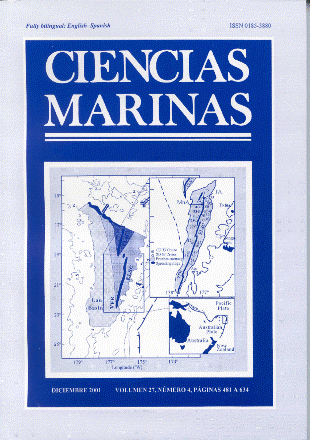Relationships between environmental variables and the abundance of Peracarid fauna in Algeciras Bay (Southern Iberian peninsula)
Main Article Content
Abstract
The distribution and abundance of peracaridean fauna associated with the bryozoan Bugula neritina have been analysed according to their possible relationships with environmental stress on the coastline of Algeciras Bay. The spatial environmental variability along this bay has been established based on the analysis of five abiotic variables (hydrodynamism, siltation, suspended solids, and organic matter content) at six stations over a 12-month period. The temporal variability of these abiotic variables was not taken into account due to the method used in collecting the samples. The abundance and beta diversity of the peracarid fauna were also calculated monthly. Hydrodynamism was the only abiotic variable significantly correlated with beta diversity, with a linear regression model between the two variables (r = 0.81). The distributional pattern of the peracarids (based on the abundance matrix) was correlated with the environmental variables by matching samples' similarities using the Spearman rank correlation. This analysis showed that the combination of variables that best explains the patterns of distribution is hydrodynamism and siltation (ρs = 0.665). Of the species considered the amphipods Ischyrocerus inexpectatus, Jassa marmorata and Podocerus variegatus were negatively correlated with hydrodynamism and positively with temperature. The caprellidea Phtisica marina was also negatively correlated with hydrodynamism. On the other hand, the amphipods Cressa mediterranea and Stenothoe dollfusi preferred environments with high hydrological forces and low sedimentation rate. Due to the particular environmental conditions where they live and their requirements, Gammaropsis maculata, Corophium acutum, J. marmorata, I. inexpectatus, and P. variegatus were categorised as good indicator species in port environments. Others such as Aora spinicornis, Microjassa cumbrensis, and C. mediterranea were categorised as species well adapted to high hydrological forces.
Downloads
Article Details
This is an open access article distributed under a Creative Commons Attribution 4.0 License, which allows you to share and adapt the work, as long as you give appropriate credit to the original author(s) and the source, provide a link to the Creative Commons license, and indicate if changes were made. Figures, tables and other elements in the article are included in the article’s CC BY 4.0 license, unless otherwise indicated. The journal title is protected by copyrights and not subject to this license. Full license deed can be viewed here.

